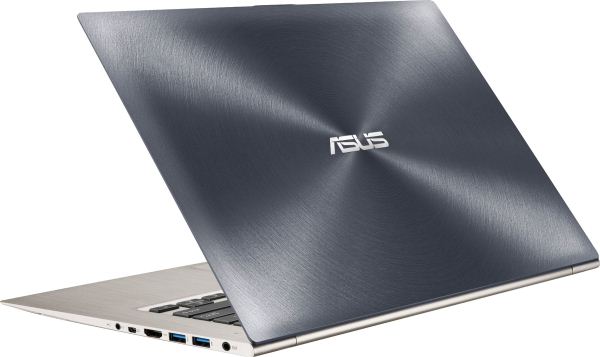Holiday 2012 Ultrabook and Ultraportable Guide
by Jarred Walton on December 12, 2012 4:00 AM ESTHigh-End Ultrabooks
Wrapping things up, we enter the final category of Ultrabooks and ultraportables, though these days we’re dealing almost exclusively with the former. In some cases we’re just getting the final high-end components from the previous category (Core i7 and 240/256GB SSDs), but there are a few other extras out there that might be worth the extra money. Let’s start with one of those.
High-End Ultrabook with Gaming Potential
The Acer M5 certainly packs a fairly potent CPU and GPU combination into an affordable package, but the overall quality of some elements is lacking. The display in particular is a sore spot, so what if you could get a similar laptop but with a 1080p IPS display? What you’d end up with is the ASUS UX32VD-DH71. It’s the big brother of the UX32A, which mostly means the display isn’t 1366x768 junk and you get a Core i7 CPU. You also get a GeForce GT 620M GPU, which actually isn’t all that fast, but it’s still probably twice the performance of the HD 4000 and you’re not as apt to throttle the CPU. Because of the design, you can also use standard 2.5” SSDs, making it possible to ditch the 500GB HDD and go for something faster. As noted earlier, Windows 8 is also shipping on the UX32VD now, so if you’re not keen on the new UI consider ClassicShell or Start8 as a good way to fix what MS broke. The UX32VD-DH71 currently sells for around $1300.
Hello 1080p Touchscreens!
At present, there are two 1080p Ultrabooks with touchscreens that I’m aware of, and we have them both in for testing. Each has some perks as well as a few quirks, so both are worthy of consideration.
Acer Aspire S7
I have to say, the first time you see the Aspire S7, you’ll very likely wonder if the Acer logo on the back isn’t a mistake. This is an extremely attractive laptop, and to my knowledge it’s the thinnest laptop anyone has ever shipped—it’s a whopping 0.47” (11.9mm) thick, which is in thick tablet territory! Acer’s 1080p display is good if not exceptional (colors are not anywhere close to accurate, though it’s at least reasonably bright), and you can go for either a Core i5-3317U with a 128GB SSD ($1300) or spend $350 more to get a Core i7-3517U with a 256GB SSD—actually, it’s technically two 64GB SSDs or two 128GB SSDs in RAID 0, which is one of the quirks. Anyway, if the $350 upsell sounds like highway robbery (it is!), we recommend the Core i5 model—95% of the performance, but with half the internal storage. One of the coolest things about both Windows 8 Ultrabooks that I’ve tested is that they can complete a full boot into the OS in about 10 seconds, and with the touchscreens the Windows 8 UI at least makes a bit of sense.
The biggest issues I have with the Aspire S7 (full review forthcoming) are the keyboard and the touchscreen. Starting with the latter, there’s no real issue as such, but reaching across the keyboard to touch the display feels a bit cumbersome. What the S7 needs is a way to turn into an actual tablet, like the Lenovo Yoga on the previous page or the Dell XPS 12 we’ll get to in a moment. You can lay the screen flat (180 degree hinge), but that’s not the same as a tablet. The keyboard is a far more irksome design, unfortunately, at least in my view. You see, I like to use keyboard shortcuts and that means using the function keys; Acer has chopped off the fifth row of keys, merging the function keys with the numbers. There are some other odd key locations as well, but the missing function keys is my biggest complaint. Given enough time I could probably adapt, but every other laptop and keyboard I use has function keys so it still frustrates me.
If Acer does a revised S7 in early 2013, changing the keyboard and creating a real tablet mode need to be at the top of their list. Pricing is also going to raise some eyebrows. I know people spend a lot of money on certain laptop brands, but those are generally business laptops or Apple products. I have a difficult time believing people will pay anywhere near $1300 for the base model S7-391, or $1200 for the 11.6” S7-191, regardless of how nice they look, simply because Acer’s brand lacks the necessary cachet.
Dell XPS 12
If you take all of the interesting points from the Acer S7 and fix the keyboard along with creating a workable tablet mode, you get the Dell XPS 12. This is actually one of the coolest laptops I’ve seen in some time, and while I was concerned about the “flip-screen” aspect holding up long-term when I first saw it, in hand the mechanism feels quite robust. Short of some abuse or an accident, the hinges feel like they’ll last many years. And that’s good, because the flip-screen is really cool. You can use the XPS 12 as a regular laptop, or you can flip the screen 180 degrees and close it, creating a tablet. One thing that’s very obvious is that the XPS 12 is quite a bit thicker than any Android or iOS tablets, but the Core i5/i7 Ivy Bridge processor at its heart is also substantially faster than any of the ARM or Atom parts we’ve seen elsewhere.
Besides the cool factor of the display, the XPS 12 comes in a variety of configurations. The base model has the 12.5" 1080p IPS panel, 4GB RAM, 128GB SSD, and an i5-3317U processor for $1200. Sadly, there’s no 8GB i5-3317U configuration, so the next step up gets you 8GB RAM and an i7-3517U for $1400—a $1250 configuration with just the 8GB RAM upgrade would have been perfect. Moving beyond that point, you can go back to the i5-3317U and get 8GB RAM, but you get a 256GB SSD, all for a starting price of $1500. Finally, there’s the no-holds-barred version that gives you the 8GB RAM, i7-3517U, and a 256GB SSD for $1700. I really like the design of the XPS 12, but the price gouging is enough to make me cry; $200 for a $25 RAM upgrade and a 100-200MHz CPU clock speed increase is laughable, and $200 to upgrade from a 128GB to a 256GB SSD is just as bad. But, if you want what is arguably the coolest Ultrabook around right now, that’s the price of entry.
Wrap-Up
This guide specifically focused on Ultrabooks and ultraportables, which eliminates a huge portion of the mobile market. We’ll look at doing other mobile guides in the coming days that get into the areas we’ve missed, including gaming laptops, other budget offerings, and even tablets. For now, we’ve listed about a dozen laptops that we could recommend for various reasons. Not every laptop would be a good fit for every person, but if you want something that’s easy to carry around—either for work, school, or some other reason—you should have several worthy options to consider. What did we miss, or do you have a converse opinion on any of our recommendations? Let us know in the comments!













77 Comments
View All Comments
marc1000 - Wednesday, December 12, 2012 - link
What about this unusual notebook from Asus? Near-ultrabook size with a touch screen AND conventional keyboard. What's your opinion about it?Abdar19 - Wednesday, December 12, 2012 - link
I am not sure why there is so much aggression on this forum over how people spend their money rather than the products in particular.I seem to see this comparison between a 5lb $500 laptop that is twice as thick compared to something 3-4lb at $1000+ dollars. Whether or not it is worth it is kind of missing the point. I think the problem is lack of variety. Let me clarify that, there is a lack of variety in unique options, there are many options. Ideally one would be able to set a price and a set of features and have a laptop that fits. To jump from 500 to 1000 dollars to get the next group of features is obscene and that is the problem.
I found one of the only truely intriguing options from Acer being the M5. It sits right in the middle of the price range for $700. Newegg has a $100 coupon now so you can buy a 128gb msata drive and install windows on it instead. This effectively makes it have all of the features of a $1000 (minus the screen) but plus a GOOD graphics card for $700. Value for money then I would argue this is really the sweet spot. Price itself is only a side point in this kind of debate, or should be I think.
tmok2008 - Wednesday, December 12, 2012 - link
The HP ENVY TouchSmart Ultrabook 4t-1100 is very slick looking. It is 3-4 lbs, and has a 14" touch screen, although not 1080p. The price is reasonable, starting at $799 MSRP. If you look around for a coupon code, you may even save a few bucks.Personally, I don't like small screens. I would take a 15" over a 13" any day. For me, the HP Spectre XT Touchsmart with a 15.6" 1080p IPS touch screen would be a better choice. It's not an "Ultrabook", but it is still under 5 lbs.
wpwoodjr - Thursday, December 20, 2012 - link
The HP Spectre XT TouchSmart is an Ultrabook. I got one recently, very nice except for 4 hour battery life. My review is here:http://www.amazon.com/review/R8FI1889QG6Y3/
bogieworf - Wednesday, December 12, 2012 - link
There are about 5 different approaches to this class of device:1) traditional ultrabook with the idea that all you need to do is make a regular laptop small/ thin enough and light enough
2) "yoga" type fold over convertible
3) Dell XPS 12 "flip" screen
4) MS touch/type cover
5) tablet/laptop that connects to a keyboard (ie Transformer)
Some of these ideas are going to take hold, others will vanish. In addition, the marketplace has not yet decided the compromises it will embrace in this kind of device and the ones it will reject. I think we all see that many people are carrying a phone and tablet/e-Reader around and maybe a laptop. And I think most of use would like to go down to at least two devices. So what is it? A phablet and a laptop? A phone and a convertible? Or keep all 3 as long as the price is low enough for each?
Over time, the answers will come. Today, all we can offer are best guesses.
JNo - Wednesday, December 12, 2012 - link
Although the Acer M5 is great, it seems that it's older brother, the M3, is even better value possibly. It misses a few modern niceties such as USB 3.0 but it has a still fast enough i5 coupled with what I understand is the full power GT 640M (not the LE version in the M5). And it's cheaper and still very thin. Win win all round for value gaming laptop if you're happy not to have the very latest specs...JarredWalton - Wednesday, December 12, 2012 - link
The M3 version has a slightly slower SNB processor, and while the 640M is technically faster than the 640M LE, the M3 uses a DDR3 variant while the 640M LE is GDDR5. It basically ends up better in some cases, slightly worse in others, depending on the game and settings. Personally, I like having GDDR5 memory on my midrange mobile GPUs, and the M5 is easier to find in stock.Pojosama - Wednesday, December 12, 2012 - link
I recently purchased the Yoga 13, and I think it's an excellent product. Using any of these touchscreen ultrabooks in tablet mode is pretty ridiculous considering the size and weight, but I love being able to flip the screen back and use the keyboard as a stand. It's also nice that you can put the laptop into tent mode to use as a second monitor, so when you touch it, it doesn't wobble. Really, if Windows 8 is good for anything, it's for being a trojan horse for forcing manufacturers to create super thin, light, versatile products. I love where products like the iPad and Windows 8 are pushing computers.Good stuff all around. Ultrabooks are made for ultimate convenience: they are very snappy performers and are light enough to move around easily. You definitely get what you pay for, in my opinion.
And yes, they DO look classy. There's nothing wrong with a bit of superficiality with our tech products.
Electromikey - Wednesday, December 12, 2012 - link
I've got the UX32VD, which I promptly stuck a Samsung 830 SSD into. I've owned it for about four months, and I absolutely love this thing. It lessened the load of my backpack by quite a bit (had a big ol' entertainment-focused monster before), and I can still play games on the go if I want to. Nothing incredibly taxing, but LAN party fodder is a piece of cake. The display is, as stated, absolutely gorgeous, and the keys are actually rather good for typing. I'm a "HULK SMASH KEYBOARD WHILE TOUCH TYPING" kind of touch typist, and these things give me rather decent feedback. Worth every penny I paid for it.alfling - Thursday, December 13, 2012 - link
No mentions about the Asus UX51VZ? <2cm thick, <2Kg, 15,6" 1080p IPS matte screen, i7-3612QM, Nvidia GT650M 2GB GDDR5, 6 hours battery...not an ultraportable?